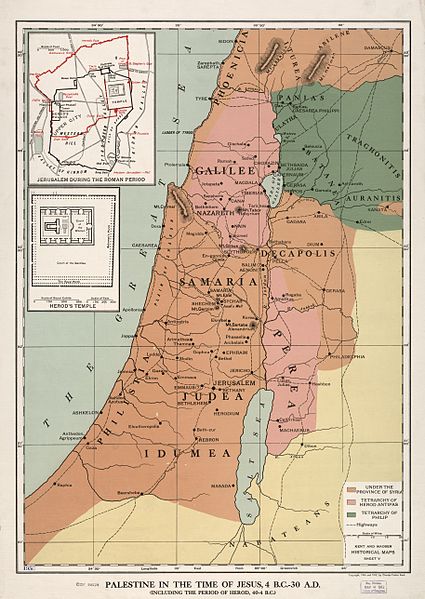Luke 3 is the third chapter of the Gospel of Luke in the New Testament of the Christian Bible, traditionally attributed to Luke the Evangelist, a companion of Paul the Apostle on his missionary journeys. It contains an account of the preaching of John the Baptist as well as a genealogy of Jesus. From the start of this chapter until Luke 9:50, the "shape and outlook" of Luke's Gospel follow closely those of the other synoptic gospels, Matthew and Mark. The Expositor's Greek Testament states that in this chapter "the ministry of the new era opens".
Luke 3:7-8 with commentary in majuscule on the underwriting of Codex Zacynthius, a palimpsest from 7th-century. The upper writing is 13th-century minuscule of Matthew 26:39-51.
Territories and tetrarchies in the first-century Palestine: Judea, Galilee, Iturea, Trachonitis, Abilene; also Perea, Nabatea, Idumea, Samaria, Decapolis, Chalcis, Phoenicia
Sandals with modern straps, but of a similar style as the sandals in Roman times
A part of Luke's genealogy of Jesus (Luke 3:23-26), from the Book of Kells, transcribed by Celtic monks c. 800
The New Testament provides two accounts of the genealogy of Jesus, one in the Gospel of Matthew and another in the Gospel of Luke. Matthew starts with Abraham and works forwards, while Luke works back in time from Jesus to Adam. The lists of names are identical between Abraham and David, but differ radically from that point. Matthew has twenty-seven generations from David to Joseph, whereas Luke has forty-two, with almost no overlap between them or with other known genealogies. They also disagree on who Joseph's father was: Matthew says he was Jacob, while Luke says he was Heli.
Ancestors of Christ by Armenian manuscript illuminator Toros Roslin
South dome of inner narthex at Chora Church, Istanbul, depicting the ancestors of Christ from Adam onwards
Patrilineage in Matthew was traditionally illustrated by a Tree of Jesse showing the descent of Jesus from Jesse, father of King David.
Tree of Jesse illustration based on the Hortus deliciarum of Herrad of Landsberg (12th century)








